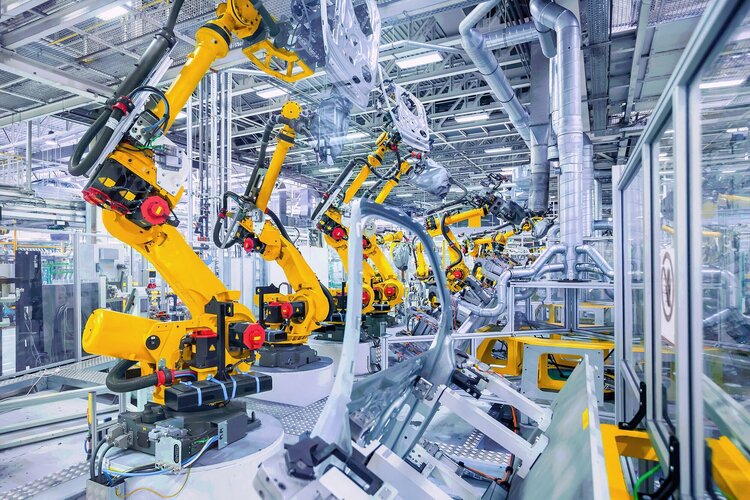Editor’s Note: DBizInstitute is excited to share this article, written by Dr. Setrag Khoshafian, with our community and in advance of his new book release. Keep an eye on our website as we share additional articles in the coming months written by Setrag, as well as a pending Meet the Author webcast to discuss his new book ‘How to Alleviate Digital Transformation Debt’ expected to air Fall 2021. This article was originally published on CognitiveWorld.com on August 23, 2020.
This is the third installment in a ten-part article series on Digital Transformation Debt, post-Covid-19. Part 1 focused on Culture, and Part 2 delved deeper into Operational Excellence and inter-enterprise Value Streams As A Service.
The Covid-19 pandemic is pushing many enterprises to re-consider their modernization and digital transformation initiatives, especially in regard to Automation. Even before the Covid-19 pandemic, there were already developments in play that were completely transforming the workforce. Post-Covid-19, the labor world will be quite different from what we once knew. Enterprises entrenched in rigid structures and the unwillingness to change, will not survive.
Impact of Covid-19 on Automation
A 2017 study indicated Automation threatens 800 million jobs and that 1/3rd of workers need to learn new skills by 2030. Another study elucidated the advantages of Automation; reducing waste, eliminating human errors, and removing six or more hours of repetitive work on average, according to some workers.
Enter Covid-19 pandemic.
McKinsey estimates 57 million US jobs, and 59 million European jobs are at risk due to Covid-19. Add automation risks to that, and you have a double whammy! Here is how they describe it: “We find significant overlap between the workers who are vulnerable in the current downturn and those who hold jobs susceptible to Automation in the future. In addition to the effects of technology, the crisis itself may create lasting changes in consumer behavior and health protocols. To put vulnerable workers on more promising and sustainable paths, the US response should incorporate a longer-term view about the resulting occupational shifts and the development of skills.” As shown in the Recommendation section below, the current accumulation of the crises could also be an excellent opportunity!
The Spectrum of Automation in the Covid-19 Era
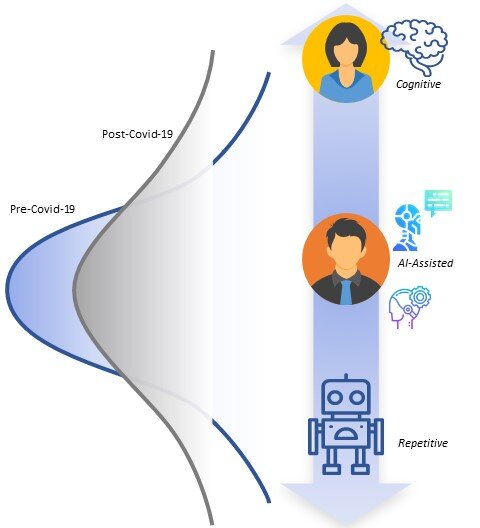
There is a spectrum of work and worker types when it comes to Automation – as illustrated here. With Covid-19, we are starting to witness significant shifts, being directly reflected within the workforce. Automation is reducing the more mundane, and even some not-so-mundane, tasks. All industry sectors are impacted. This, of course, implies the loss of jobs in many sectors and industries. As we discussed in Part 1, there are also virtualization cultural shifts that are impacting work automation, particularly in customer services.
- Repetitive Work – Automated through Robots and Robotic Automation: Increasingly, robots are replacing routine, predictable, and repetitive manual work. This is the “long tail” of tasks that are allocated to relatively low paying repetitive jobs that are managed by the business vs. IT. These are now are increasingly automated with robots: These include actual physical robots that can, for instance, operate a warehouse moving boxes around or clean the floor in large plants, and of course, you have extensive robotics in Manufacturing. We can also have software robots. Repetitive desktop tasks, for instance, could be automated through robotic software automation — saving a considerable amount of time and avoiding potential human errors. Covid-19 is causing a sharp increase in Automation in all sectors.
- AI-Assisted Work: Now, for more mission-critical and higher business value (and typically higher transaction volume) tasks, you have AI-assisted workers that are guided by increasingly intelligent software that leverages business rules, analytics, and machine learning. It is like having a smart Siri or Alexa, helping the worker complete their tasks. Increasingly, workers are assisted by bots and Intelligent Virtual Assistants with extremely sophisticated Natural Language Processing capabilities combined with the knowledge that is contextual for the task or interaction at hand. Most organizations reduced customer service staffing during Covid-19. Organizations are increasingly relying on chatbots that often make the initial identification of customer issues and then involve an agent, and more importantly, advanced customer service technologies are assisting the customer service representatives.
- Cognitive Work: Cognitive workers are the experts. We saw a sharp increase in telehealth and virtual visits in the healthcare sector. The expert doctors and nurses are the irreplaceable cognitive workers par excellence, as are the healthcare payer and providers. Telehealth witnessed a substantial increase at the start of the pandemic and is expected to level off in the coming months. All industry sectors are experiencing both remote work with AI-assisted Automation and involvement of cognitive workers who are exceptionally good in providing their expertise and dealing with exceptions. No “Artificial” intelligence will be able to replace cognitive workers. The human touch and involvement are even more critical during the Covid-19 era. The knowledge and know-how of this vital category of workers needs to be harvested and digitized. Ideally, they need to work closely with data scientists; to complement human knowledge with data and machine discovered models. Most importantly, their experience needs to be harvested and digitized in the context of end-to-end value streams.
Industry 4.0 in the Covid-19 Era
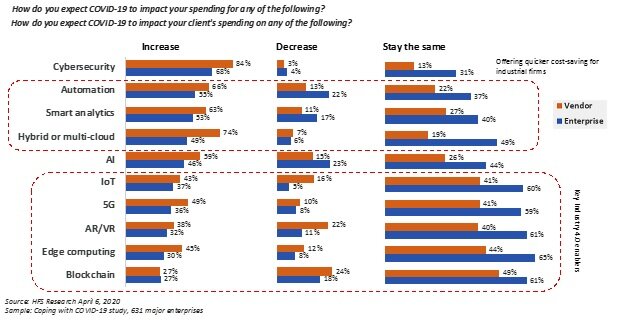
In Process as well as Discrete Manufacturing, even before the pandemic, manufacturers were introducing Automation and increasingly sophisticated robotics and edge computing deployed in all phases of the supply chain. With Covid-19, Robotics and Automation are becoming critical in Manufacturing, especially discrete Manufacturing, which has evolved to Industry 4.0. The manufacturing industry – especially automotive original equipment manufacturers (OEMs) – were in a significant digital transition, and Covid-19 accelerated and increased primarily for Automation, Analytics, and the Cloud. According to one study, IoT and AR will potentially experience a decrease in spending. It remains to be seen, especially since Automation with IoT connectivity extends beyond the shop floor.
Automation and connectivity of manufactured devices for vehicles or automotive fleets are disrupting the relationship dynamics of the manufacturers, dealers, suppliers, service organizations, and, most importantly, consumers. In the emerging era of Industry 4.0 and smart Manufacturing, the value streams from manufacturing to aftermarket services are radically transformed.
The connectivity of manufacturers to customers, and specifically for automotive OEMs, is shifting to a much closer, monitored, and responsive relationship. In Process Manufacturing, we are witnessing the increased deployment of automated and semi-automated drones and robots. Intelligence and Automation are also increasingly deployed at the edges – which often alleviates the need for human interventions or contact: Again, a critical trend that was already in play but has become crucial post-Covid-19.
Warehouse and Supply Chain Management, which is critical in many industries, showed serious vulnerabilities during the pandemic, and we are starting to see movement to optimize and change both in digitization, Automation, and diversity of sourcing. However, pressure on workers, especially for supplies that are in high demand combined with the concerns over the safety of the workers, has become a fertile ground for Automation for warehouses and supply chain in general. While there were already trends towards Automation, Covid-19 accelerated the utilization of robots for a variety of purposes in warehouses: packaging, scanning, moving boxes, cleaning floors, and identifying items (to name a few).
Driving the Enterprise-in-Motion with Hyperautomation
Automation is the engine that powers and moves the Enterprise-in-Motion. Even before Covid-19, Gartner had identified hyperautomation as the number one trend in 2020. It “deals with the application of advanced technologies, including artificial intelligence (AI) and machine learning (ML), to increasingly automate processes and augment humans. Hyperautomation extends across a range of tools that can be automated, but also refers to the sophistication of the Automation.”

Robotic Process Automation (RPA) – especially for repetitive tasks in the front or back office – is a powerful enabler for hyperautomation. So is AI for intelligent and virtual assistants. With RPA instead of human workers (e.g., agents or customer service representatives) copying information between various screens or traversing a plethora of legacy applications a software robot instead automatically achieves the same repetitive tasks: much faster and with fewer errors. There are also other batch-oriented applications of RPA. However, before deploying an RPA solution, organizations realize they need first to identify the automation opportunities and then automate the repetitive tasks or introduce intelligent agents of Automation. Operational Excellence experts know that automating bad processing could make matters even worse. RPA is no panacea. The following two rules on technology from Bill Gates are spot-on: “The first rule of any technology used in a business is that Automation applied to an efficient operation will magnify the efficiency. The second is that Automation applied to an inefficient operation will magnify the inefficiency.”
Enter Process Mining.
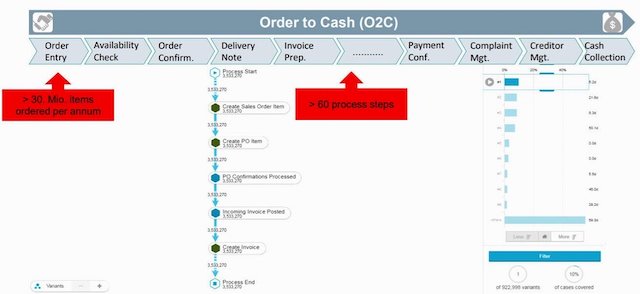
Briefly, through process mining, the organization can analyze the transaction logs of their systems of record and mine for insights and optimization opportunities. Process mining, followed by careful analysis for operational efficiency, should precede any deployment or execution efforts with RPA or intelligent Business Process Management (iBPM). Process mining discovers process maps and all their variations from the transactional data logs. It is not a good idea to automate bad processes. Knowledge of the quality of processes needs careful analysis. So, this becomes a necessary step and enabler for successful RPA. It can then provide intelligent analysis identifying bottlenecks and operational excellence opportunities through Automation – especially RPA.
The Siemens Order to Cache(O2C) process improvement with process mining is a compelling case study. It is highlighted here and in more detail in Chapter 9 of Process Mining in Action. The key performance improvement objective is the average number of manual touches required for the order. The process has 60 steps and 30 million activities per year. There are more than 900,000 variations of the process! After the analysis and identification of opportunities, the operational excellence results were impressive: A higher rate of Automation by 24%, an 11% reduction in rework, and 10 million fewer manual touches a year.
Automation Strategy (AS)
Enterprises of all sizes are generating enormous amounts of data, and typically there are several types of silos that cause a considerable amount of waste. This is addressed in Part 2.
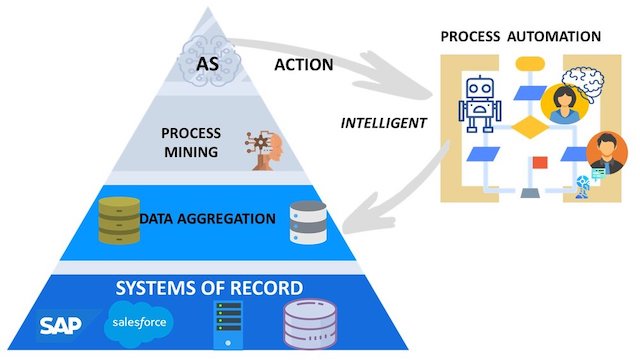
Enterprises involve many siloed systems of record. The data is aggregated to a plethora of SQL and NoSQL intelligent databases. Then various patterns are detected through data mining and process mining. The business logic and process models are then analyzed within an overall Automation Strategy. The low hanging fruits – processes with high value and potential automation optimization – can then be operationalized in end-to-end Process Automation solutions. More specifically, the Action leverages the Intelligence harvested from the data or human cognitive experts and then executes them in through Automated Processes.
Intelligent Process Automation enablers for digitizing value streams connecting customers, partners, and the entire ecosystem of organizations are all available through technologies such as Robotic Process Automation (RPA) and intelligent Business Process Management (iBPM). Connecting various siloes in the organizations will become critical. However, here again, the potential hindrances to connectivity are cultural. The ROI of Process Automation emanates from three complementary and interdependent areas:
- Process efficiency in planning and deploying innovations: The continuous innovation and deployment involve four Digital Transformation methodologies: Design Thinking, Agile, DevOps, and Operational Excellence. It starts with prioritization – thinking big for Automation but starting small with the most impactful low hanging fruits.
- Process efficiency in automated execution: The spectrum of Automation summarized above – from robotics to AI-assisted to cognitive worker participation – is critical for resolving manual handoffs and silos. The completion and resolution of end-to-end value streams can be optimized from days to hours due to process automation.
- Process efficiency through monitoring and improvement: Out of the box business activity monitoring dashboards, reports, and automated alerts dynamically monitor if work is processed on time, contractual SLAs are being met, and if processes are running optimally. These are actionable monitoring reports – where managers, for instance, can re-assign tasks from under-performers to others.
Recommendation: Entrepreneurship and Innovation through Automation
Automation, combined with Covid-19, is causing a crisis in the labor market. It will only get worse. Technology will advance, and it will automate more. Covid-19 is having a tremendous impact on behaviors – cultural implications whose ramifications will be felt for many generations.
As we have shared earlier on Covid-19 trends, the “Crisis” is a danger for the job security and the economy at large. But it is also an opportunity. Here are the top recommendations for Automation:
- Reskill and Upskill: Organizations need to leverage the lockdown and the gain in time due to work-from-home directives to upskill and reskill their employees. Automation is coming. The unstoppable shifts are towards more Automation of repetitive work and increasingly the emergence of the cognitive worker. Both are reskilling and upskilling opportunities.
- Prioritization for Automation: The most important deliverable of the ideation phase in Design Thinking is Prioritization. Operational Excellence methodologies also include Prioritization. Automation has a spectrum of opportunities and enterprises embarking upon robust Automation Strategy roadmaps need to identify and continuously revise the low hanging fruits of Automation.
- Process and Data Mining: Be bold and analyze your as-is processes honestly. The majority of enterprises understand the increasingly important area of Data Science and Data Mining. But they lack skills and understanding of Process Science and Process Mining. We shall delve deeper into this in a subsequent article. For now, it is critical to develop Process Mining skills and deploy it as an essential component of an overall Automation Strategy initiative.
- Entrepreneur and Startup mind frame: Perhaps most importantly, enterprises of all sizes need to prioritize and focus on innovation opportunities. Automation is disruptive. It is also powerful, and a robust Automation Strategy can ensure survival and growth amid the Covid-19 uncertainties. Every organization needs to operate in a startup mentality and Culture – with enthusiasm, empowerment, and innovative thinking permeating the very DNA of the organization.
This is a ten-part article series centered around Digital Transformation Debts in the wake of the Covid-19 pandemic. Be sure to check out all ten articles!
